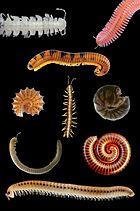| Cowiedesmus Temporal range: Wenlock/Lochkovian PreꞒ Ꞓ O S D C P T J K Pg N | |
|---|---|
| Scientific classification | |
| Kingdom: | Animalia |
| Phylum: | Arthropoda |
| Subphylum: | Myriapoda |
| Class: | Diplopoda |
| Subclass: | Chilognatha |
| Superorder: | †Archipolypoda |
| Order: | †Cowiedesmida |
| Family: | †Cowiedesmidae |
| Genus: | †Cowiedesmus Wilson & Anderson, 2004 |
| Type species | |
| Cowiedesmus eroticopodus | |
Cowiedesmus is an extinct millipede genus described from Scotland, and is considered as earliest known land animals alongside Pneumodesmus from same formation. It is originally considered that it is from the middle Silurian, a 2017 study suggested that the geological formation it contains actually appears to be from the Early Devonian (Lochkovian) instead. Although a 2023 study confirmed the age identification of the 2004 study through palynological, palaeobotanical and ziron analyses incorporating newly discovered additional data, this is based on adjacent structurally separated block with different stratigraphy and sedimentology to the block with fossil site it was discovered, and it is confirmed as unsustainable. Cowiedesmus was about 4 cm (1.6 in) long and characterized by a greatly enlarged pair of legs on the 8th segment which may have been used in clasping females or functioned as gonopods (modified legs used to insert sperm during mating). Coweiedesmus is distinct enough from other living and fossil millipedes to be placed in its own order, Cowiedesmida. The only known species, C. eroticopodus, was described in 2004.
The name Cowiedesmus references the Cowie Formation, a geological formation at Cowie Harbor, near the village of Stonehaven, Scotland, where the fossil was found and desmus, a common root word in millipede nomenclature meaning "bond" or "bridge". The specific epithet eroticopodus means "erotic foot".
References
- ^ Wilson, Heather M.; Anderson, Lyall I. (2004). "Morphology and taxonomy of Paleozoic millipedes (Diplopoda: Chilognatha: Archipolypoda) from Scotland". Journal of Paleontology. 78 (1): 169–184. doi:10.1666/0022-3360(2004)078<0169:MATOPM>2.0.CO;2.
- Russell Garwood & Gregory Edgecombe (2011). "Early terrestrial animals, evolution and uncertainty". Evolution: Education and Outreach. 4 (3): 489–501. doi:10.1007/s12052-011-0357-y.
- Suarez, Stephanie E.; Brookfield, Michael E.; Catlos, Elizabeth J.; Stöckli, Daniel F. (28 June 2017). "A U-Pb zircon age constraint on the oldest-recorded air-breathing land animal". PLOS ONE. 12 (6): e0179262. doi:10.1371/journal.pone.0179262. ISSN 1932-6203. PMC 5489152. PMID 28658320.
- Wellman, C.H.; Lopes, G.; McKellar, Z.; Hartley, A. (2023). "Age of the basal 'Lower Old Red Sandstone' Stonehaven Group of Scotland: The oldest reported air-breathing land animal is Silurian (late Wenlock) in age". Journal of the Geological Society. The Geological Society of London. doi:10.1144/jgs2023-138. hdl:2164/22754. ISSN 0016-7649.
- Brookfield, M. E.; Catlos, E. J.; Garza, H. (7 July 2024). "The oldest 'millipede'-plant association? Age, paleoenvironments and sources of the Silurian lake sediments at Kerrera, Argyll and Bute, Scotland". Historical Biology: 1–13. doi:10.1080/08912963.2024.2367554. ISSN 0891-2963.
| Orders of the class Diplopoda (millipedes) | |||||||||||||||||||||||||||||||||
|---|---|---|---|---|---|---|---|---|---|---|---|---|---|---|---|---|---|---|---|---|---|---|---|---|---|---|---|---|---|---|---|---|---|
| |||||||||||||||||||||||||||||||||
| |||||||||||||||||||||||||||||||||
| |||||||||||||||||||||||||||||||||
| Taxon identifiers | |
|---|---|
| Cowiedesmus | |
This prehistoric myriapod-related article is a stub. You can help Misplaced Pages by expanding it. |
This Scotland-related article is a stub. You can help Misplaced Pages by expanding it. |

